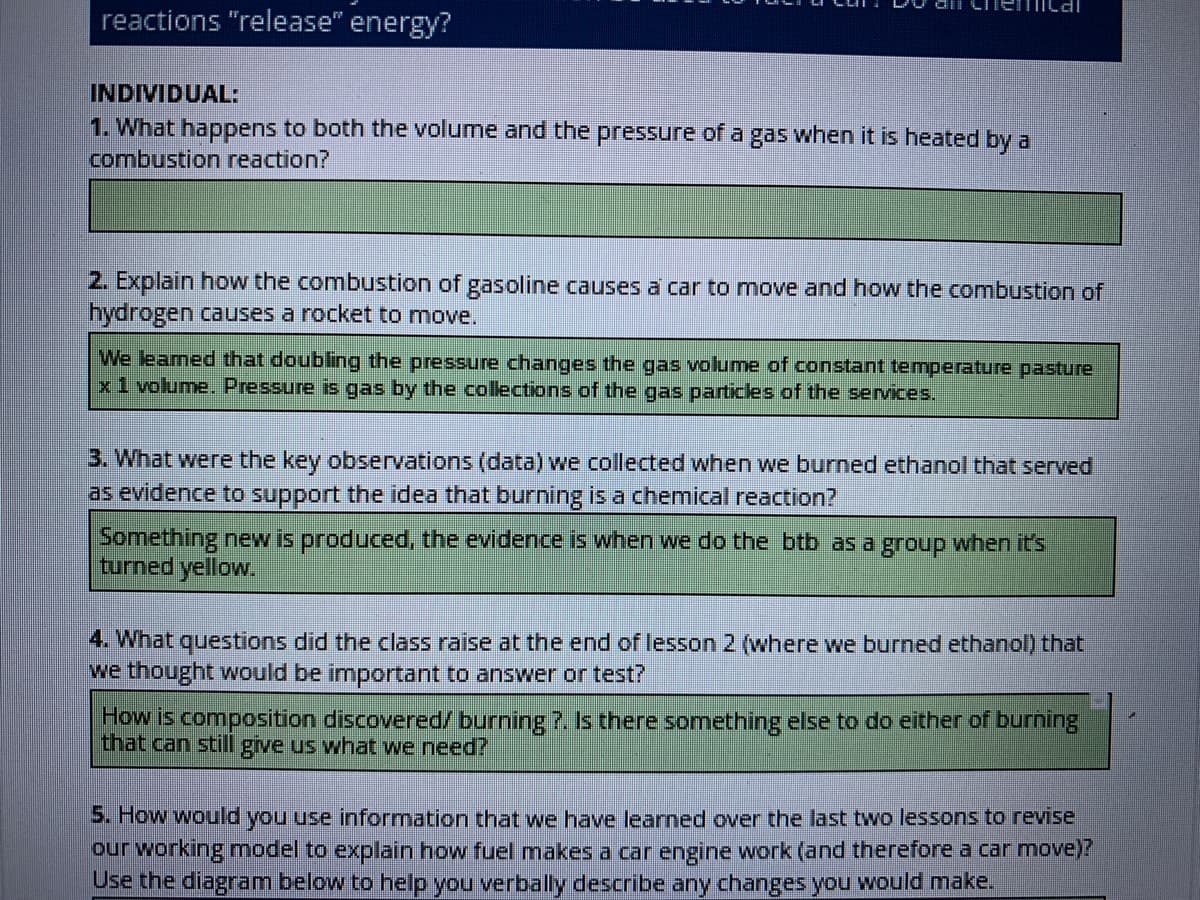Chapter5: Gases
Section: Chapter Questions
Problem 165MP
Related questions
Question
I need question 1 please

Transcribed Image Text:Ilal
reactions "release" energy?
INDIVIDUAL:
1. What happens to both the volume and the pressure of a gas when it is heated by a
combustion reaction?
2. Explain how the combustion of gasoline causes a car to move and how the combustion of
hydrogen causes a rocket to move.
We leamed that doubling the pressure changes the gas volume of constant temperature pasture
x1 volume. Pressure is gas by the colections of the gas particles of the services.
3. What were the key observations (data) we collected when we burned ethanol that served
as evidence to support the idea that burning is a chemical reaction?
Something new is produced, the evidence is when we do the btb as a group when it's
turned yellow.
4. What questions did the class raise at the end of lesson 2 (where we burned ethanol) that
we thought would be important to answer or test?
How is composition discovered/ burning 7. Is there something else to do either of burning
that can still give us what we need?
5. How would you use information that we have learned over the last two lessons to revise
our working model to explain how fuel makes a car engine work (and therefore a car move)?
Use the diagram below to help you verbally describe any changes you would make.
Expert Solution
This question has been solved!
Explore an expertly crafted, step-by-step solution for a thorough understanding of key concepts.
This is a popular solution!
Trending now
This is a popular solution!
Step by step
Solved in 2 steps

Knowledge Booster
Learn more about
Need a deep-dive on the concept behind this application? Look no further. Learn more about this topic, chemistry and related others by exploring similar questions and additional content below.Recommended textbooks for you


Chemistry
Chemistry
ISBN:
9781305957404
Author:
Steven S. Zumdahl, Susan A. Zumdahl, Donald J. DeCoste
Publisher:
Cengage Learning

Chemistry: An Atoms First Approach
Chemistry
ISBN:
9781305079243
Author:
Steven S. Zumdahl, Susan A. Zumdahl
Publisher:
Cengage Learning


Chemistry
Chemistry
ISBN:
9781305957404
Author:
Steven S. Zumdahl, Susan A. Zumdahl, Donald J. DeCoste
Publisher:
Cengage Learning

Chemistry: An Atoms First Approach
Chemistry
ISBN:
9781305079243
Author:
Steven S. Zumdahl, Susan A. Zumdahl
Publisher:
Cengage Learning


Introductory Chemistry: A Foundation
Chemistry
ISBN:
9781337399425
Author:
Steven S. Zumdahl, Donald J. DeCoste
Publisher:
Cengage Learning

General Chemistry - Standalone book (MindTap Cour…
Chemistry
ISBN:
9781305580343
Author:
Steven D. Gammon, Ebbing, Darrell Ebbing, Steven D., Darrell; Gammon, Darrell Ebbing; Steven D. Gammon, Darrell D.; Gammon, Ebbing; Steven D. Gammon; Darrell
Publisher:
Cengage Learning